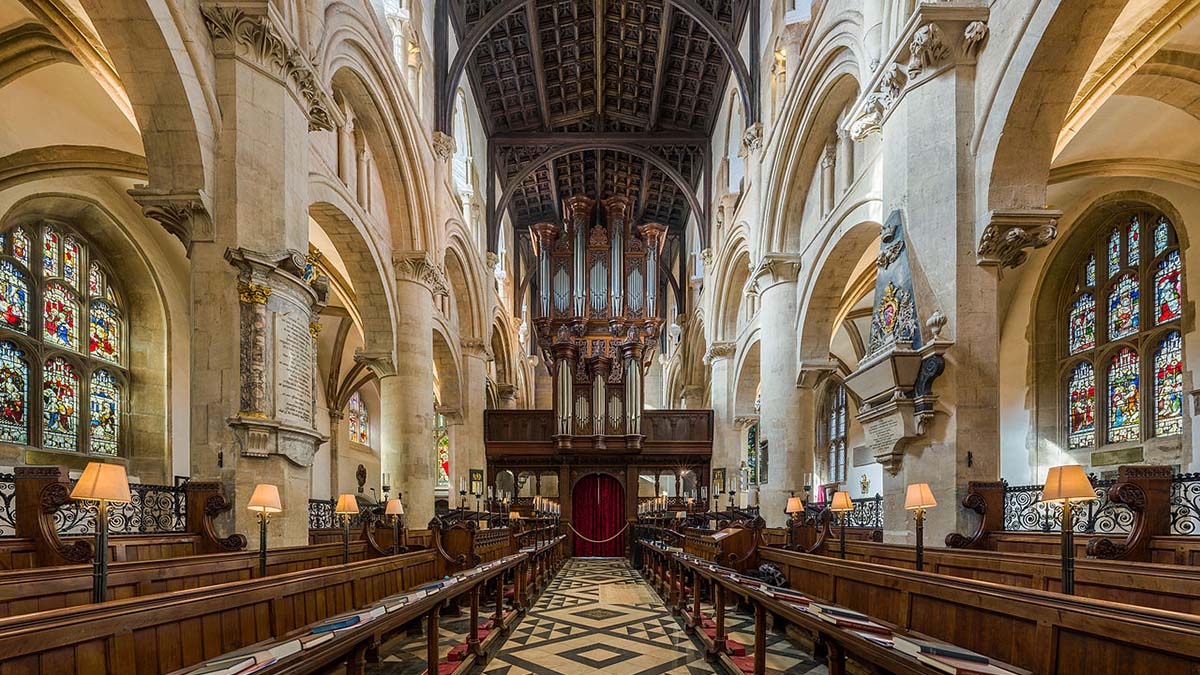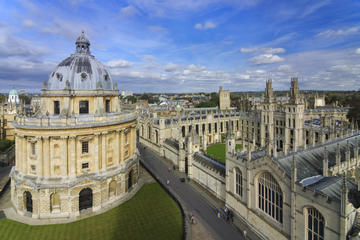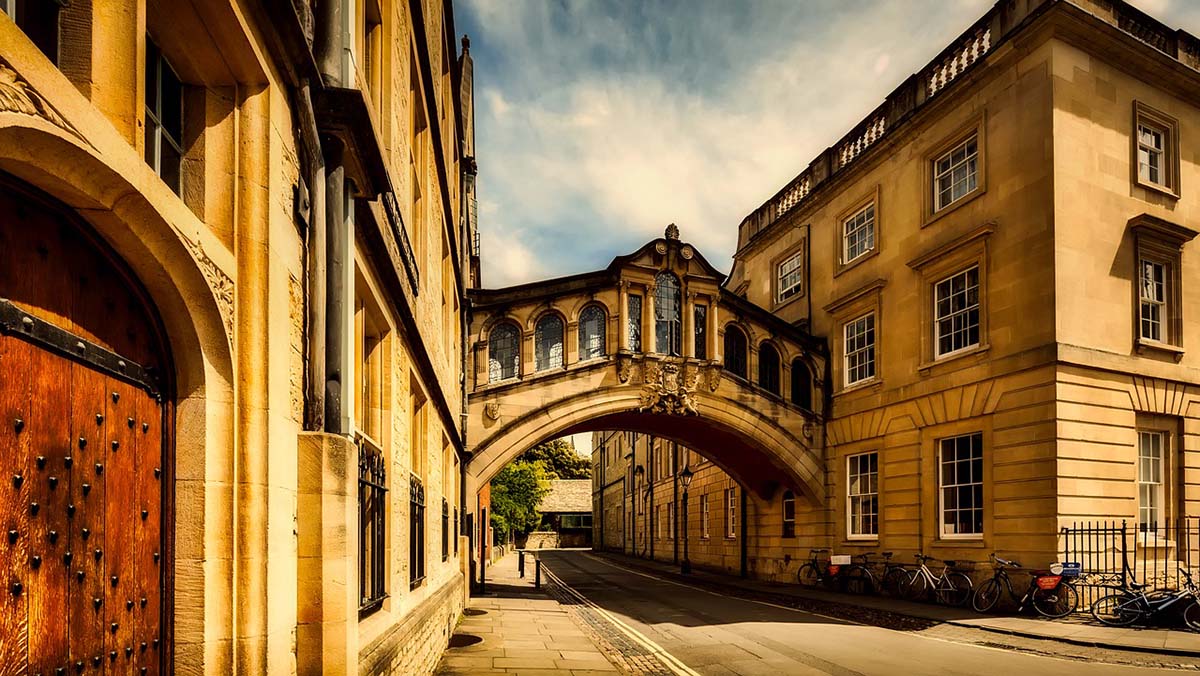
by Pauline Lucy
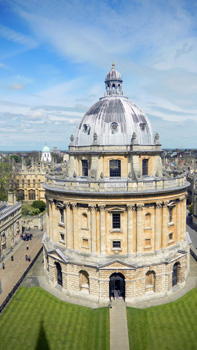 The city of Oxford is spread out before me as I stand on the tower parapet of the Church of St. Mary the Virgin. The staircase is a narrow, twisting spiral, challenging to manoeuvre as I squeezed past people who were coming down. The climb is one hundred and twenty four steps to get to the walkway just below the spire, but once up there I can see a complete three hundred and sixty degree view of Oxford. The buildings are nestled very closely together, made of honey-coloured limestone lit up in the sunshine. It is breezy at the top. I tie my scarf more tightly so that it won’t blow off and flutter over the wall. The stone figures on the walls play tricks on my eyes and look like they are about to crawl down to the next level. They have postures like Gollum crouching, ready to leap from place to place.
The city of Oxford is spread out before me as I stand on the tower parapet of the Church of St. Mary the Virgin. The staircase is a narrow, twisting spiral, challenging to manoeuvre as I squeezed past people who were coming down. The climb is one hundred and twenty four steps to get to the walkway just below the spire, but once up there I can see a complete three hundred and sixty degree view of Oxford. The buildings are nestled very closely together, made of honey-coloured limestone lit up in the sunshine. It is breezy at the top. I tie my scarf more tightly so that it won’t blow off and flutter over the wall. The stone figures on the walls play tricks on my eyes and look like they are about to crawl down to the next level. They have postures like Gollum crouching, ready to leap from place to place.
My cousin, Kevin, and his family point out the famous landmark buildings of the university from the tower,
“There is Christ Church to the left.” Kevin points to the magnificent building surrounding a pristine green lawn. “We passed The Bridge of Sighs as we walked to St. Mary’s did you see it?” He asks.
“Yes, I did, is it designed like the one in Venice?” I reply.
 He smiles mischievously. “It is actually called Hertford Bridge and looks more like the Rialto Bridge in Venice. They are often confused. When we get back down to ground level, shall we hunt for a place to eat?” Kevin suggests.
He smiles mischievously. “It is actually called Hertford Bridge and looks more like the Rialto Bridge in Venice. They are often confused. When we get back down to ground level, shall we hunt for a place to eat?” Kevin suggests.
My cousin loves Oxford and has visited many times while his daughter attended the university. He likes to share many interesting details and gets very animated during his story telling.
He showed me a doorway near St. Mary’s that is said to have inspired C.S. Lewis’ “The Lion, the Witch and the Wardrobe.”
We headed back down to the street to explore the sights of this over eight hundred year old city.
 I walked with my family down the cobblestone streets to a charming pub called “The Eagle and Child”. The building is lopsided due to its age, and several additions have been made to it over time, so the rooms are angled in odd ways. The little nooks and crannies have intimate spaces filled with small tables and chairs arranged for private conversations and philosophical discussions. The walls are covered with paintings and sketches of famous personages like J.R.R. Tolkien and C.S. Lewis. I was in awe that I walked on the floor and sat in the building where these creators of famous literature regularly met.
I walked with my family down the cobblestone streets to a charming pub called “The Eagle and Child”. The building is lopsided due to its age, and several additions have been made to it over time, so the rooms are angled in odd ways. The little nooks and crannies have intimate spaces filled with small tables and chairs arranged for private conversations and philosophical discussions. The walls are covered with paintings and sketches of famous personages like J.R.R. Tolkien and C.S. Lewis. I was in awe that I walked on the floor and sat in the building where these creators of famous literature regularly met.
After lunch my cousin had booked a one hour tour of the Bodleian Library. It is a book depository, no one can take a book from the library, a person can request to see a book but it must be kept on the premises. The library opened in 1602 and the collection has expanded spilling over to many other buildings over the past four hundred years.
The Divinity School is connected to the Bodleian and that is where I wait for the tour to begin.
In those few minutes I gaze at the ceiling of the room. It has upswept cone-like shapes with tiny details etched into the stone. The window frames are massive and made of many small panes of glass. The guide gathers us together on two long wooden benches. She starts with a little history about herself.
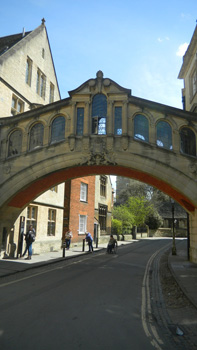 “Good afternoon everyone and welcome to the Bodleian Library.” The guide greets us and beckons the group to come closer. “You are probably curious about my accent. You can tell that I am not from here, I am American. I came to Oxford for a visit several years ago and fell in love with the city.” She says with a warm smile. “I decided that I wanted to be a part of it, so I am a volunteer in the Bodleian and give tours. I am excited to begin and share as much information about it as I can in this brief hour. Let’s begin, this room was used as the hospital in the Harry Potter movies.” She keenly announces.
“Good afternoon everyone and welcome to the Bodleian Library.” The guide greets us and beckons the group to come closer. “You are probably curious about my accent. You can tell that I am not from here, I am American. I came to Oxford for a visit several years ago and fell in love with the city.” She says with a warm smile. “I decided that I wanted to be a part of it, so I am a volunteer in the Bodleian and give tours. I am excited to begin and share as much information about it as I can in this brief hour. Let’s begin, this room was used as the hospital in the Harry Potter movies.” She keenly announces.
The tour continued and I visited the Duke Humfrey’s Medieval Library where Hermione Granger did much of her research. The books are chained to the shelves in keeping with the rules that the books cannot be removed from the room.
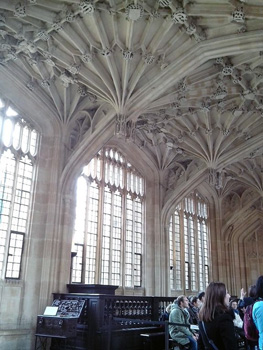 Across the square from the Bodleian is the Sheldonian Theatre built by Sir Christopher Wren. To my surprise the theatre is not used to perform plays, but hosts concerts and degree ceremonies.
Across the square from the Bodleian is the Sheldonian Theatre built by Sir Christopher Wren. To my surprise the theatre is not used to perform plays, but hosts concerts and degree ceremonies.
Oxford is the home of many unique and precious objects, “The Messiah”, a virtually unplayed Stradivarius violin is protected under glass in the Ashmolean Museum. The most complete remains of a dodo found anywhere in the world is displayed in the Museum of Natural History. A day is really too short a time to see all of Oxford’s treasures.
The atmosphere in Oxford is a juxtaposition of time standing still and the frenetic energy of young students rushing around on bicycles through the narrow, crowded streets.
The buildings are interspersed with gardens and lawns that offer a resting place to calm my mind. I learned extensive information about the people, architecture and history that seeps from every brick.
As I left Oxford I was impressed by the city, it is preserved and yet it is moving forward embracing new ideas and welcoming the brilliant minds of today.
If You Go:
♦ Oxford University’s official site
♦ Oxford City Guide
♦ Oxford Bulidings
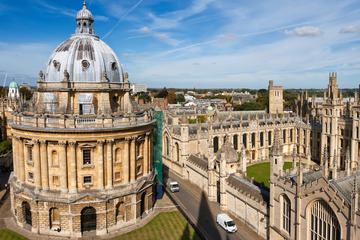
3-Hour Private Oxford Guided Walking Tour
About the author:
Born in England, Pauline Lucy grew up in Quebec after her family immigrated to Canada. After finishing her Bachelor of Education Degree at McGill University and teaching in Quebec, she moved to British Columbia. Pauline taught primary classes in Burnaby until 2013. She loves the imaginative world of children’s books and enjoys rich, figurative language. Since retiring she has cruised through the Panama Canal, toured in China and recently visited her birthplace.
Photo Credits:
First Oxford photo by David Mark from Pixabay
All other photos are by Pauline Lucy.



